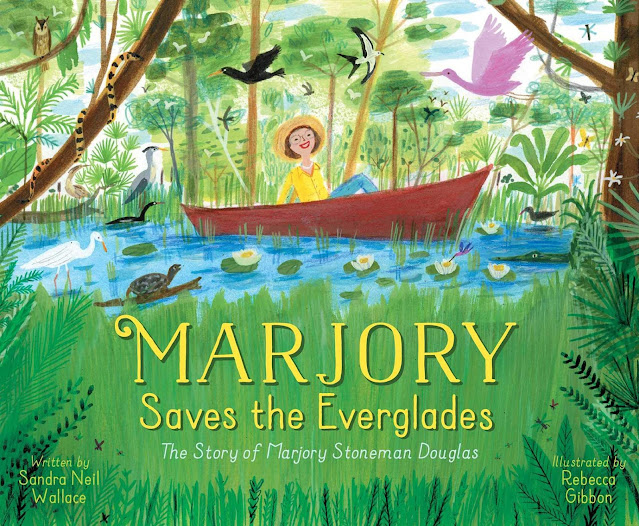Marjory Saves the Everglades: The Story of Marjory Stoneman Douglas written by Sandra Neil Wallace, illustrated by Rebecca Gibbon
Marjory Saves the Everglades:
The Story of Marjory Stoneman Douglas
written by Sandra Neil Wallace, illustrated by Rebecca Gibbon
Review Copy from Simon & Schuster
While the narrative style of Marjory Saves the Everglades is gently meandering and almost fairy tale like at times, Gibbon's illustrations bring a sunny warmth to the natural world that is central to the story of the woman who worked most of her long life (she was 108 when she died in 1998) to save the Florida Everglades.
The author spends the first ten pages covering aspects of Marjory's life, up to the age of twenty-seven, that don't feel entirely important to the work of the rest of her long life and left me wondering if those pages could have been used to take a deeper dive into Marjory's work as a writer, researcher, environmentalist and unwitting activist. Moving to Florida in 1915, Marjory takes a job as the only female journalist at her father's newspaper, the Miami Herald. Joining the US Naval Reserve (and the Red Cross) in 1917, Marjory sailed to Europe help in the war efforts and report on the war. Her activist spark was ignited when, in 1920, Marjory returned to a Florida that looked very different from the one she left.
With the help of others, Stoneman Douglas began educating herself on the Everglades, working to preserve what most considered a swampland to be drained and repurposed. At the age of fifty-seven, the same year that Everglades National Park opened, Stoneman Douglas published The Everglades: River of Grass, which remains an influential book on nature conservation and the importance of preserving the Everglades. In 1969, with her vision and hearing impaired, in an effort to stop a jetport from being built in the Everglades, Marjory formed Friends of the Everglades, becoming an environmental activist. A vocal supporter, she was booed and called a "butterfly chaser" when she spoke at events, but, even at the age of ninety-three, she continued to fight for the restoration of the Everglades and return it to a river of grass.
An Author's note provides significant information that could have been better served in the story, especially the fact that "members of the Seminole Tribe of Florida and the Miccosukee Tribe of Indians of Florida worked together to fight against legislation seeking to take the Everglades land or pollute it." There is also a page of flora and fauna found in the Everglades, "Marjory's Tips for Protecting the Environment," more on how you can help, a timeline (which was especially helpful making in sense of the story), sources and additional sources.






